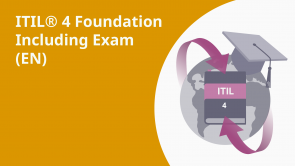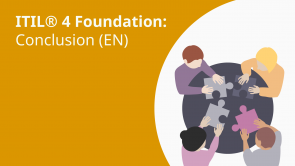ITIL® 4 Foundation: Sample Exam 1

Über den Vortrag
Der Vortrag „ITIL® 4 Foundation: Sample Exam 1“ von Dion Training ist Bestandteil des Kurses „ITIL® 4 Foundation: Conclusion (EN)“.
Quiz zum Vortrag
Which practice is responsible for moving components to live environments? (Copyright © AXELOS Limited 2019, usage approved by AXELOS Limited. All rights reserved.)
- Deployment management
- Change control
- Release management
- IT asset management
Which practice includes the classification and ownership of queries and requests from users? (Copyright © AXELOS Limited 2019, usage approved by AXELOS Limited. All rights reserved.)
- Service desk
- Incident management
- Change control
- Service level management
Which practice identifies metrics that reflect the customer’s experience of a service? (Copyright © AXELOS Limited 2019, usage approved by AXELOS Limited. All rights reserved.)
- Service level management
- Continual improvement
- Service desk
- Problem management
What is the PRIMARY use of a change schedule? (Copyright © AXELOS Limited 2019, usage approved by AXELOS Limited. All rights reserved.)
- To plan changes and help avoid conflicts
- To support 'incident management' and improvement planning
- To manage emergency changes
- To manage standard changes
Which service management dimension is focused on activities and how these are coordinated? (Copyright © AXELOS Limited 2019, usage approved by AXELOS Limited. All rights reserved.)
- Value streams and processes
- Organizations and people
- Information and technology
- Partners and suppliers
How does categorization of incidents assist the ‘incident management’ practice? (Copyright © AXELOS Limited 2019, usage approved by AXELOS Limited. All rights reserved.)
- It helps direct the incident to the correct support area
- It determines the priority assigned to the incident
- It ensures that incidents are resolved in timescales agreed with the customer
- It determines how the service provider is perceived
Identify the missing word(s) in the following sentence. A service is a means of enabling value co-creation by facilitating [?] that customers want to achieve. (Copyright © AXELOS Limited 2019, usage approved by AXELOS Limited. All rights reserved.)
- outcomes
- the warranty
- the utility
- outputs
Which is a recommendation of the ‘continual improvement’ practice? (Copyright © AXELOS Limited 2019, usage approved by AXELOS Limited. All rights reserved.)
- There should at least be a small team dedicated to leading ‘continual improvement’ efforts
- All improvements should be managed as multi-phase projects
- ‘Continual improvement' should be isolated from other practices
- External suppliers should be excluded from improvement initiatives
Which is a potential benefit of using an IT service management tool to support the 'incident management' practice? (Copyright © AXELOS Limited 2019, usage approved by AXELOS Limited. All rights reserved.)
- It may provide automated matching of incidents to problems or known errors
- It may ensure that the cause of incidents is identified within agreed times
- It may ensure that supplier contracts are aligned with the needs of the service provider
- It may provide automated resolution and closure of complex incidents
Which role submits service requests? (Copyright © AXELOS Limited 2019, usage approved by AXELOS Limited. All rights reserved.)
- The user, or their authorized representative
- The customer, or their authorized representative
- The sponsor, or their authorized representative
- The supplier, or their authorized representative
Which practice provides a single point of contact for users? (Copyright © AXELOS Limited 2019, usage approved by AXELOS Limited. All rights reserved.)
- Service desk
- Incident management
- Change control
- Service request management
Which guiding principle recommends that the four dimensions of service management are considered? (Copyright © AXELOS Limited 2019, usage approved by AXELOS Limited. All rights reserved.)
- Think and work holistically
- Progress iteratively with feedback
- Focus on value
- Keep it simple and practical
Which would be supported by the ‘service request management’ practice? (Copyright © AXELOS Limited 2019, usage approved by AXELOS Limited. All rights reserved.)
- A request from a user for something which is a normal part of service delivery
- A request to authorize a change that could have an effect on a service
- A request to restore service after a service interruption
- A request to investigate the cause of multiple related incidents
Which practice is the responsibility of everyone in the organization? (Copyright © AXELOS Limited 2019, usage approved by AXELOS Limited. All rights reserved.)
- Continual improvement
- Service level management
- Change control
- Problem management
Identify the missing word in the following sentence. The purpose of the ‘information security management’ practice is to [?] the organization’s information. (Copyright © AXELOS Limited 2019, usage approved by AXELOS Limited. All rights reserved.)
- protect
- store
- provide
- audit
Which guiding principle recommends collecting data before deciding what can be re-used? (Copyright © AXELOS Limited 2019, usage approved by AXELOS Limited. All rights reserved.)
- Start where you are
- Focus on value
- Keep it simple and practical
- Progress iteratively with feedback
Which is NOT usually included as part of incident management? (Copyright © AXELOS Limited 2019, usage approved by AXELOS Limited. All rights reserved.)
- Detailed procedures for the diagnosis of incidents
- Scripts for collecting initial information about incidents
- Formalized procedures for logging incidents
- The use of specialized knowledge for complicated incidents
Which describes the nature of the guiding principles? (Copyright © AXELOS Limited 2019, usage approved by AXELOS Limited. All rights reserved.)
- Guiding principles can guide an organization in all circumstances
- Each guiding principle mandates specific actions and decisions
- An organization will select and adopt only one of the seven guiding principles
- Guiding principles describe the processes that all organizations must adopt
Which statement about a change authority is CORRECT? (Copyright © AXELOS Limited 2019, usage approved by AXELOS Limited. All rights reserved.)
- A change authority should be assigned for each type of change and change model
- A single change authority should be assigned to authorize all types of change and change models
- Normal changes are pre-authorized and do not need a change authority
- Emergency changes can be implemented without authorization from a change authority
Which practice has the purpose of making new and changed services and features available for use? (Copyright © AXELOS Limited 2019, usage approved by AXELOS Limited. All rights reserved.)
- Release management
- Change control
- Service request management
- Deployment management
Which value chain activity ensures people understand the organization’s vision? (Copyright © AXELOS Limited 2019, usage approved by AXELOS Limited. All rights reserved.)
- Plan
- Improve
- Deliver and support
- Obtain/build
Which statement about the value chain activities is CORRECT? (Copyright © AXELOS Limited 2019, usage approved by AXELOS Limited. All rights reserved.)
- Each value chain activity contributes to the value chain by transforming specific inputs into outputs
- Every practice belongs to a specific value chain activity
- A specific combination of value chain activities and practices forms a service relationship
- Service value chain activities form a single workflow that enables value creation
What is the purpose of the ‘supplier management’ practice? (Copyright © AXELOS Limited 2019, usage approved by AXELOS Limited. All rights reserved.)
- To ensure that the organization‘s suppliers and their performance are managed appropriately to support the seamless provision of quality products and services
- To align the organization's practices and services with changing business needs through the ongoing identification and improvement of services
- To ensure that the organization’s suppliers and their performance are managed appropriately at strategic and tactical levels through coordinated marketing, selling, and delivery activities
- To ensure that accurate and reliable information about the configuration of suppliers' services is available when and where it is needed
What are the two types of cost that a service consumer should evaluate? (Copyright © AXELOS Limited 2019, usage approved by AXELOS Limited. All rights reserved.)
- The costs removed by the service, and the costs imposed by the service
- The price of the service, and the cost of creating the service
- The cost of provisioning the service, and the cost of improving the service
- The cost of software, and the cost of hardware
Which is a purpose of the ‘service desk’ practice? (Copyright © AXELOS Limited 2019, usage approved by AXELOS Limited. All rights reserved.)
- To capture demand for incident resolution and service requests
- To reduce the likelihood and impact of incidents by identifying actual and potential causes of incidents
- To maximize the number of successful IT changes by ensuring risks are properly assessed
- To set clear business-based targets for service performance
How should an organization adopt continual improvement methods? (Copyright © AXELOS Limited 2019, usage approved by AXELOS Limited. All rights reserved.)
- Select a few key methods for the types of improvement that the organization handles
- Use a new method for each improvement the organization handles
- Build the capability to use as many improvement methods as possible
- Select a single method for all improvements that the organization handles
Which ITIL concept describes governance? (Copyright © AXELOS Limited 2019, usage approved by AXELOS Limited. All rights reserved.)
- The service value system
- The seven guiding principles
- The four dimensions of service management
- The service value chain
Which is a recommendation of the ‘service desk’ practice? (Copyright © AXELOS Limited 2019, usage approved by AXELOS Limited. All rights reserved.)
- Service desks should understand the wider organization
- Service desks should avoid the use of automation
- Service desks should be highly technical
- Service desks should be a physical team in a single fixed location
Which guiding principle recommends organizing work into smaller, manageable sections that can be executed and completed in a timely manner? (Copyright © AXELOS Limited 2019, usage approved by AXELOS Limited. All rights reserved.)
- Progress iteratively with feedback
- Focus on value
- Start where you are
- Collaborate and promote visibility
What is a standard change? (Copyright © AXELOS Limited 2019, usage approved by AXELOS Limited. All rights reserved.)
- A change that is well understood, fully documented and pre-authorized
- A change that needs to be assessed, authorized, and scheduled by a change authority
- A change that doesn’t need a risk assessment because it is required to resolve an incident
- A change that is assessed, authorized, and scheduled as part of ‘continual improvement’
What happens if a workaround becomes the permanent way of dealing with a problem that cannot be resolved cost-effectively? (Copyright © AXELOS Limited 2019, usage approved by AXELOS Limited. All rights reserved.)
- The problem remains in the known error status
- A change request is submitted to change control
- Problem management restores the service as soon as possible
- The problem record is deleted
What is the definition of change? (Copyright © AXELOS Limited 2019, usage approved by AXELOS Limited. All rights reserved.)
- To add, modify or remove anything that could have a direct or indirect effect on services
- To ensure that accurate and reliable information about the configuration of services is available
- To make new and changed services and features available for use
- To move new or changed hardware, software, or any other component to live environments
What is the definition of an event? (Copyright © AXELOS Limited 2019, usage approved by AXELOS Limited. All rights reserved.)
- Any change of state that has significance for the management of a service or other configuration item
- Any component that needs to be managed in order to deliver an IT service
- An unplanned interruption to a service or reduction in the quality of a service
- Any financially valuable component that can contribute to the delivery of an IT product or service
Which describes outcomes? (Copyright © AXELOS Limited 2019, usage approved by AXELOS Limited. All rights reserved.)
- Results desired by a stakeholder
- Tangible or intangible deliverables
- Functionality offered by a product or service
- Configuration of an organization’s resources
Which is NOT a key focus of the ‘information and technology’ dimension? (Copyright © AXELOS Limited 2019, usage approved by AXELOS Limited. All rights reserved.)
- Roles and responsibilities
- Security and compliance
- Communication systems and knowledge bases
- Workflow management and inventory systems
Which practices are typically involved in the implementation of a problem resolution? 1. Continual improvement 2. Service request management 3. Service level management 4. Change control (Copyright © AXELOS Limited 2019, usage approved by AXELOS Limited. All rights reserved.)
- 1 and 4
- 1 and 2
- 2 and 3
- 3 and 4
Which is a key consideration for the guiding principle ‘keep it simple and practical’? (Copyright © AXELOS Limited 2019, usage approved by AXELOS Limited. All rights reserved.)
- Understand how each element contributes to value creation
- Try to create a solution for every exception
- Ignore the conflicting objectives of different stakeholders
- Start with a complex solution, then simplify
What should be done first when applying the ‘focus on value’ guiding principle? (Copyright © AXELOS Limited 2019, usage approved by AXELOS Limited. All rights reserved.)
- Determine who the service consumer is in each situation
- Identify the outcomes that the service facilitates
- Identify all suppliers and partners involved in the service
- Determine the cost of providing the service
A service provider describes a package that includes a laptop with software, licences, and support. What is this package an example of? (Copyright © AXELOS Limited 2019, usage approved by AXELOS Limited. All rights reserved.)
- A service offering
- Value
- An outcome
- Warranty
What is the definition of warranty? (Copyright © AXELOS Limited 2019, usage approved by AXELOS Limited. All rights reserved.)
- The assurance that a product or service will meet agreed requirements
- A tangible or intangible deliverable that is produced by carrying out an activity
- A possible event that could cause harm or loss, or make it more difficult to achieve objectives
- The functionality offered by a product or service to meet a particular need
Kundenrezensionen
5,0 von 5 Sternen
| 5 Sterne |
|
5 |
| 4 Sterne |
|
0 |
| 3 Sterne |
|
0 |
| 2 Sterne |
|
0 |
| 1 Stern |
|
0 |




